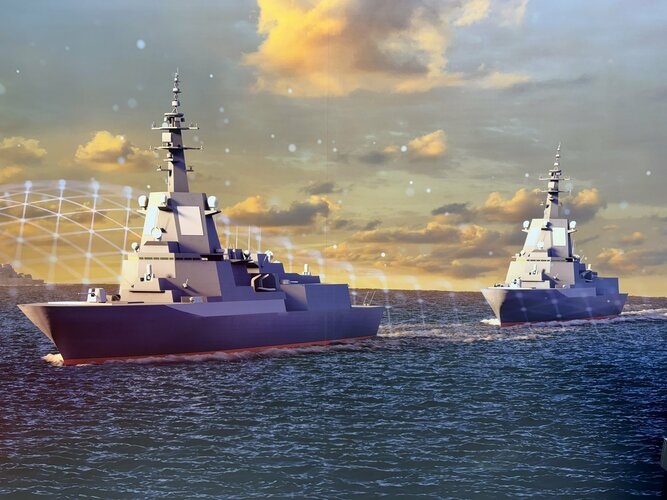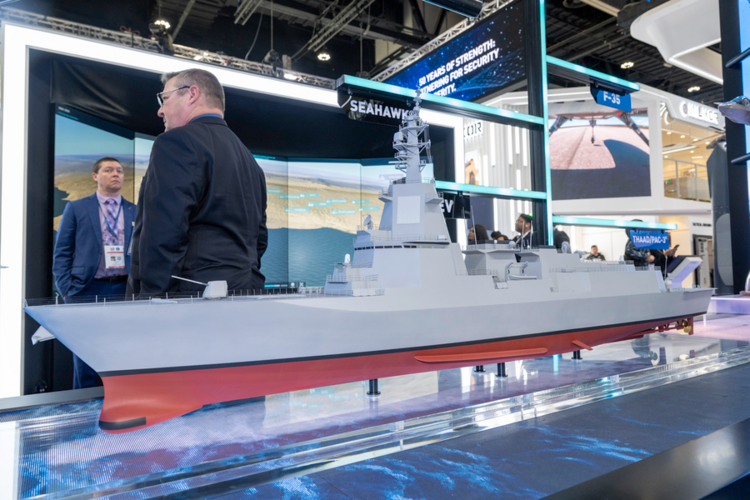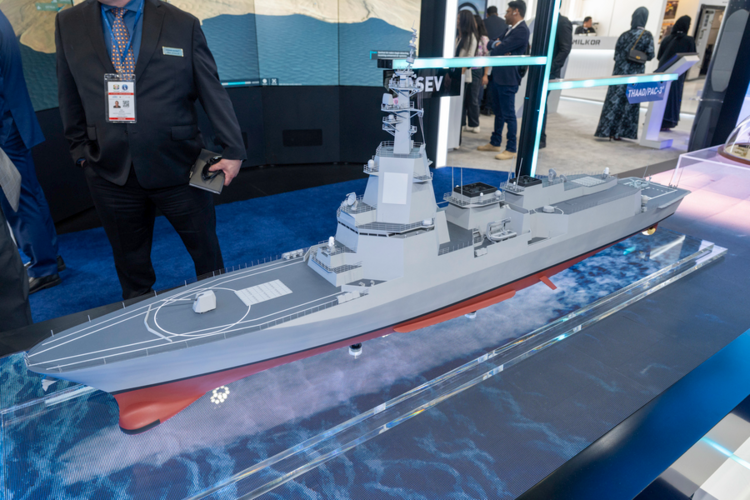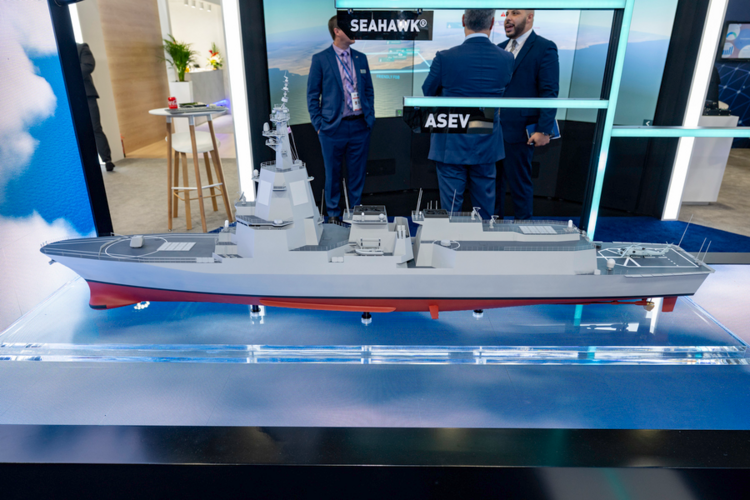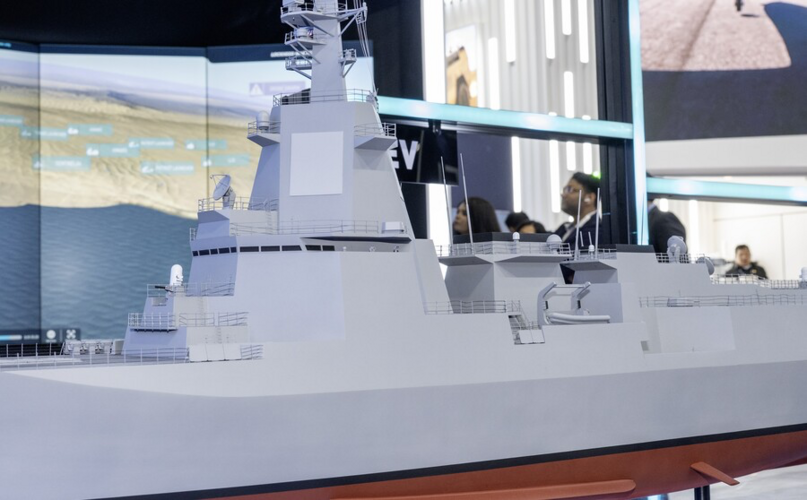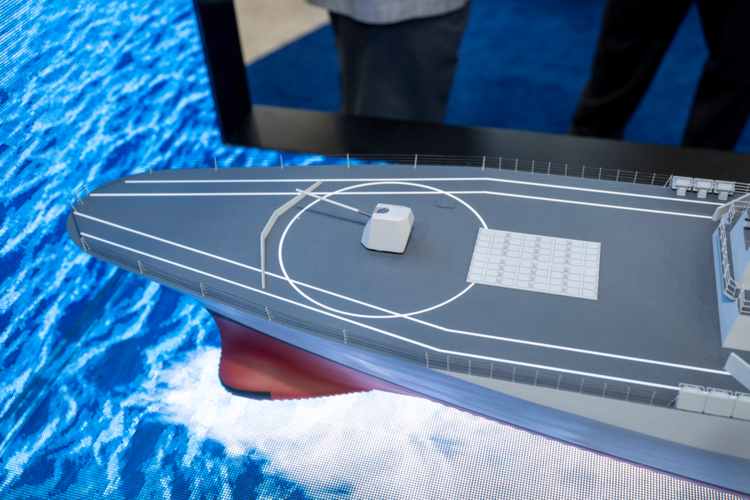Well more generally, if you take out the shore bombardment role, there really is no use for a larger caliber. If it was not for the heavy Congressional support of the USMC, 5" probably would have gone out of style and the failed Zumwalts would never have existed (rightly so).
You are using an out of date browser. It may not display this or other websites correctly.
You should upgrade or use an alternative browser.
You should upgrade or use an alternative browser.
Japan 20000t SPY-7 guided missile destroyer/cruiser
- Thread starter Kota
- Start date

Lockheed Martin Delivers First ASEV AN/SPY-7(V)1 Radar Antenna to Japan - Naval News
Lockheed Martin delivered the first AN/SPY-7(V)1 radar antenna for the Aegis System Equipped Vessel (ASEV) to the Japan Ministry of Defense.
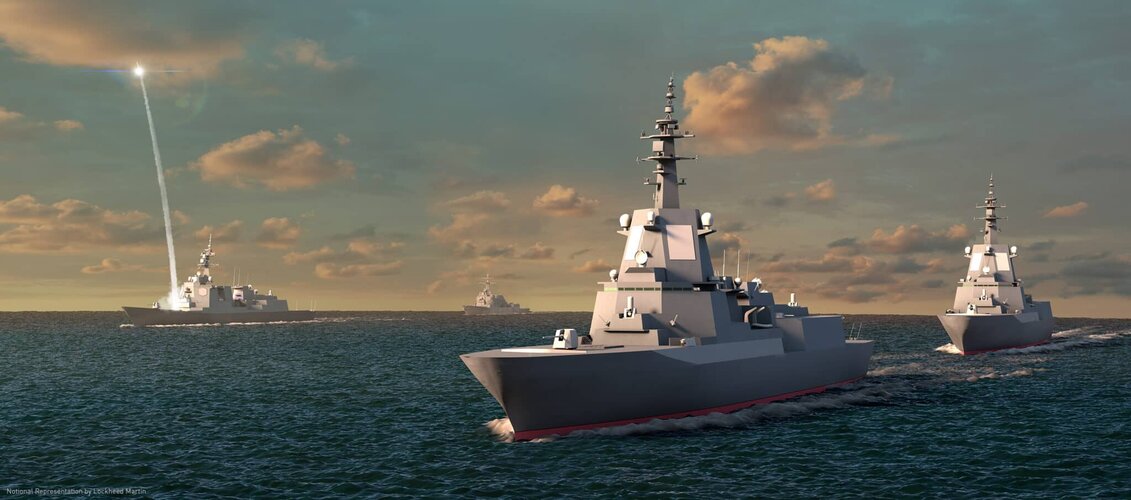
- Joined
- 11 February 2010
- Messages
- 1,650
- Reaction score
- 2,700
The Japanese articles on the delivery of the antenna :

 news.yahoo.co.jp
news.yahoo.co.jp
It has interesting information on the dimension of the array. It mentions height of 4.3 m and each SAS (Subarray Antenna System) Which how Lockheed are calling their RMA(Radar Modular Assembly). each SAS, from available imagery seems to have 37 TRM Channels. ASEV have about 328 SAS in total means 82 SAS/Array face, this constitutes 3034 elements per array face. Kinda looks lower than Raytheon's SPY-6 but based on the numbers of the elements and array dimensions it works also in lower frequency of 2214-2296 MHz (2.2-2.3 GHz) or Lower S-band, almost at the frequency used by Apollo CSM to Communicate with Earth, maybe indicating optimization toward Space Surveillance and missile defense rather than general air defense which dwell in higher S-band (about 3 GHz).

ロッキード・マーティン、SPY7レーダーの第1面を防衛省に納入と発表 海自イージスシステム搭載艦向け(高橋浩祐) - エキスパート - Yahoo!ニュース
世界最大手の防衛企業、アメリカのロッキード・マーティン(LM)は1月16日、海上自衛隊が導入するイージスシステム搭載艦(ASEV)用のSPY7レーダーの最初のアンテナ1面を防衛省に納入したと発表した。
It has interesting information on the dimension of the array. It mentions height of 4.3 m and each SAS (Subarray Antenna System) Which how Lockheed are calling their RMA(Radar Modular Assembly). each SAS, from available imagery seems to have 37 TRM Channels. ASEV have about 328 SAS in total means 82 SAS/Array face, this constitutes 3034 elements per array face. Kinda looks lower than Raytheon's SPY-6 but based on the numbers of the elements and array dimensions it works also in lower frequency of 2214-2296 MHz (2.2-2.3 GHz) or Lower S-band, almost at the frequency used by Apollo CSM to Communicate with Earth, maybe indicating optimization toward Space Surveillance and missile defense rather than general air defense which dwell in higher S-band (about 3 GHz).
The Japanese articles on the delivery of the antenna :

ロッキード・マーティン、SPY7レーダーの第1面を防衛省に納入と発表 海自イージスシステム搭載艦向け(高橋浩祐) - エキスパート - Yahoo!ニュース
世界最大手の防衛企業、アメリカのロッキード・マーティン(LM)は1月16日、海上自衛隊が導入するイージスシステム搭載艦(ASEV)用のSPY7レーダーの最初のアンテナ1面を防衛省に納入したと発表した。news.yahoo.co.jp
It has interesting information on the dimension of the array. It mentions height of 4.3 m and each SAS (Subarray Antenna System) Which how Lockheed are calling their RMA(Radar Modular Assembly). each SAS, from available imagery seems to have 37 TRM Channels. ASEV have about 328 SAS in total means 82 SAS/Array face, this constitutes 3034 elements per array face. Kinda looks lower than Raytheon's SPY-6 but based on the numbers of the elements and array dimensions it works also in lower frequency of 2214-2296 MHz (2.2-2.3 GHz) or Lower S-band, almost at the frequency used by Apollo CSM to Communicate with Earth, maybe indicating optimization toward Space Surveillance and missile defense rather than general air defense which dwell in higher S-band (about 3 GHz).
Senator Sato once said that the antenna size of SPY-7(V)1 is 5m(H) x 4.2m(W):
View: https://x.com/satomasahisa/status/1333189977543376897?s=46&t=5THFve96Abhx7VANdlTzrg
- Joined
- 11 February 2010
- Messages
- 1,650
- Reaction score
- 2,700
Senator Sato once said that the antenna size of SPY-7(V)1 is 5m(H) x 4.2m(W):
View: https://x.com/satomasahisa/status/1333189977543376897?s=46&t=5THFve96Abhx7VANdlTzrg
Thanks for the addition. Then i'm curious what was 4.3 m for mentioned in the news. Also Aegis was about 3.7 x 3.7 m. But anyway.
5 m height and 4.2 m wide, that's basically 2 GHz even lower S-band.
Scott Kenny
ACCESS: USAP
- Joined
- 15 May 2023
- Messages
- 11,599
- Reaction score
- 14,276
The ASEVs are supposed to be replacing Aegis Ashore facilities, so this makes sense.The Japanese articles on the delivery of the antenna :

ロッキード・マーティン、SPY7レーダーの第1面を防衛省に納入と発表 海自イージスシステム搭載艦向け(高橋浩祐) - エキスパート - Yahoo!ニュース
世界最大手の防衛企業、アメリカのロッキード・マーティン(LM)は1月16日、海上自衛隊が導入するイージスシステム搭載艦(ASEV)用のSPY7レーダーの最初のアンテナ1面を防衛省に納入したと発表した。news.yahoo.co.jp
It has interesting information on the dimension of the array. It mentions height of 4.3 m and each SAS (Subarray Antenna System) Which how Lockheed are calling their RMA(Radar Modular Assembly). each SAS, from available imagery seems to have 37 TRM Channels. ASEV have about 328 SAS in total means 82 SAS/Array face, this constitutes 3034 elements per array face. Kinda looks lower than Raytheon's SPY-6 but based on the numbers of the elements and array dimensions it works also in lower frequency of 2214-2296 MHz (2.2-2.3 GHz) or Lower S-band, almost at the frequency used by Apollo CSM to Communicate with Earth, maybe indicating optimization toward Space Surveillance and missile defense rather than general air defense which dwell in higher S-band (about 3 GHz).
A rule of thumb the power of the radar governed by the size of its aperture.
The Burke Flt 111 SPY-6 (V)1 has 37 Radar Modular Assembly (a mini radar) per face, a RMA is 2 cubic ft x 37 give a 148 sq ft per face, 4 faces gives a total area of 592 sq ft aperture for the (V)1.
Each RMA has 24 T/R modules so 37 x 24 = 888 T/R modules per face and for the 4 faces a total of 3,552 T/R modules
The SPY-7 for ASEV assuming each single face array is 4.3 square meters???, 46.3 sq ft, for a total for the 4 faces only 185.2 sq ft aperture???
The building blocks of the radar are the Subarray Antenna System (SAS) and it has 82 SAS per face with the 37 T/R modules in each and so 3034 T/R modules per face and a total for the 4 faces 328 SAS gives 12,136 T/R modules.
The numbers make no sense at all as expect the RTX and Lockheed S-band T/R modules would be roughly similar in size, so my assumptions and calculations must be totally wrong, but where?
The Burke Flt 111 SPY-6 (V)1 has 37 Radar Modular Assembly (a mini radar) per face, a RMA is 2 cubic ft x 37 give a 148 sq ft per face, 4 faces gives a total area of 592 sq ft aperture for the (V)1.
Each RMA has 24 T/R modules so 37 x 24 = 888 T/R modules per face and for the 4 faces a total of 3,552 T/R modules
The SPY-7 for ASEV assuming each single face array is 4.3 square meters???, 46.3 sq ft, for a total for the 4 faces only 185.2 sq ft aperture???
The building blocks of the radar are the Subarray Antenna System (SAS) and it has 82 SAS per face with the 37 T/R modules in each and so 3034 T/R modules per face and a total for the 4 faces 328 SAS gives 12,136 T/R modules.
The numbers make no sense at all as expect the RTX and Lockheed S-band T/R modules would be roughly similar in size, so my assumptions and calculations must be totally wrong, but where?
- Joined
- 11 February 2010
- Messages
- 1,650
- Reaction score
- 2,700
The numbers make no sense at all as expect the RTX and Lockheed S-band T/R modules would be roughly similar in size, so my assumptions and calculations must be totally wrong, but where?
Different architecture can, i think. You can see how RTX and Lockheed "pack" their modules
Lockheed
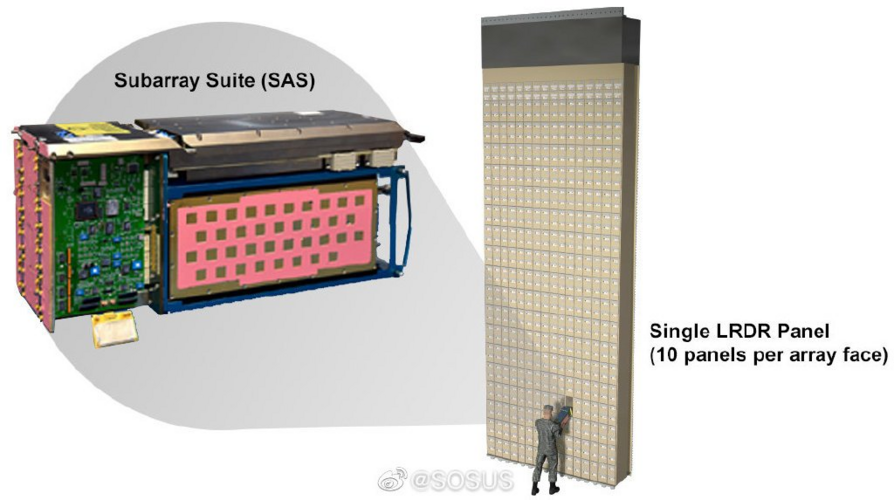
RTX
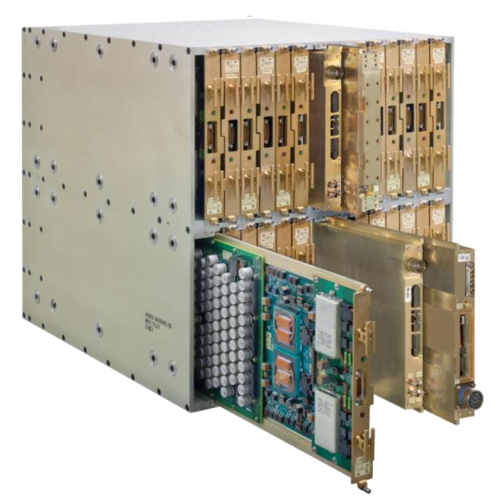
Raytheon architecture is "denser" somewhat than the Lockheed and it meant to be replaced "per card" during maintenance. While Lockheed seems to embrace some separation and to optimize liquid cooling only to the high power part, thus you can see the separation between the radiator in SAS, i think Lockheed call that HPM or High Power Module, that part only contain the GaN HPA along with some necessary parts like core chip and LNA. The SAS's control board and power supplies are external and air cooled. In return of course when maintenance or sudden module replacement is needed, you have to take the whole SAS.
---------
Regarding the antenna size tho.
I traced back to original LRDR , and turn out that the numbers provided in the article might not be necessarily correct. Based on LRDR fact sheet, the array was 10 panels with box form factor of 60 x 60 ft or 18.24 x 18.24 m. The radar is described to be consisted of 10 Panels. Thus for the given array size, each panel must be about 9.12 m high and 3.65 m in width. This give total area of 332.88 sqm or 333 sqm.
Each panel has 288 SAS, thus making it total 2880 SAS, 37 array channels (at this point, given the architecture of the SAS, terms "Transmit receive module"/TRM might no longer applicable somehow) in each SAS making it 2880 x 37 = 106560 "TRM"
Divide the antenna area with the "TRM counts" to get the element area : 333/106560 = 0.003125 sqm. Knowing that we can find the frequency.
Given the array is an early warning radar. It is safe to assume that it's a FFOV (Full Field of View) Array which scan the arc of 120 degrees. Typical array geometry would be triangular. This would give constant 0.332.
In case one curious about where this 0.332 constant coming. The deriviation is in "Radar handbook :3rd Edition" chapter about Phased array antenna.
This "scanning constant" can be used with operational wavelength to find the element area, with equation :
Ae= k* Wavelength^2
k is the scanning constant (0.332 for FFOV array, 0.397 for NFOV with scan angle of 90 degrees, good for S-300/400)
To find frequency is :
Wavelength = SQRT(0.003125/0.332)
Wavelength = 0.097 m or frequency of 3093 MHz
Now that we know the element area and of course frequencies. We can try guessing how many "Equivalent TRM counts" for the Japanese array.
If we go with Raptor82's numbers from Japanese senator of 4.2 x 5 m. That would give area of 21 sqm. to find the "TRM Equivalent" Divide that area with the element area. So :
N=21/0.003125
N=6720
Dividing that with the channels in the SAS making a panel of ASEV's SPY-7 to be 182 SAS. Thus for 4 faces the SAS needed would be 728
If we use 4.3 m as the width of the array and same height, we would arrive in "TRM counts" of 6886.
Also on TRX's SPY-6.. Each "card" actually contains 6 channels. Thus each RMA will have "equivalent TRM" counts of 144.
This is one card from an RMA :
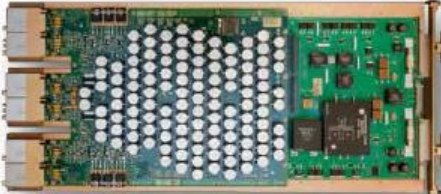
Notice the leftmost end of the card, it has 3 big "boxes" each of that box has 2 modules containing the GaN amplifiers, LNA and a core chip. Thus making total channels for that card or RTX calling it "TRIIM" to 6.
Thus 24 RMA SPY-6 would contain : 24*144 = 3456 TRM for each array face. Making it total of 13824 "TRM Equivalent" counts.
Sticking to ABM treaty value for power aperture. One can now have enough data to run Radar Range Equation. Starting from LRDR yield the following.
Peak Power/TRM : 141 Watt
Average Power/TRM : 28 Watt
106560 TRM LRDR at Alaska is able to detect ascending 10 sqm ICBM target at 8800-14000 Km.
ASEV In other hand, a scaled down article can conveniently provide 2048-3100 Km range against similar target. This is about 1.56 times more than SPY-1 ship. Below is the example coverage between estimated range of ASEV vs Aegis ship with SPY-1 radar.
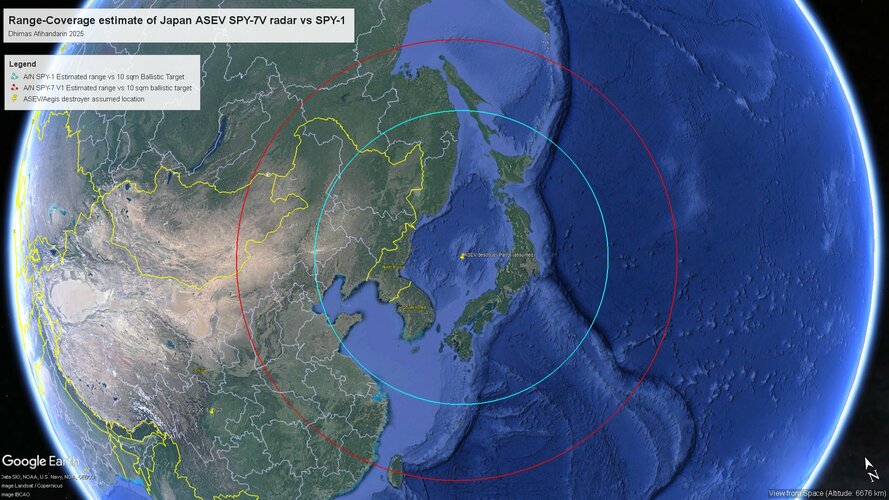
Last edited:

ASEV model @IDEX2025:
Attachments
Scott Kenny
ACCESS: USAP
- Joined
- 15 May 2023
- Messages
- 11,599
- Reaction score
- 14,276
I'm not sure that the ASEV actually has the AAW Flag space that the USN needs.Make one for us too please PLEASE! I'M BEGGIN I DON'T CARE.
Ainen
I really should change my personal text
- Joined
- 25 August 2011
- Messages
- 1,275
- Reaction score
- 1,709
JMSDF(with subcontractors) designs new surface and submarine combatants every few years.USN: "It Is VeRy HaRd To CrEaTe A nEw LaRgE wArShIp."
JMSDF: "Hold my sake and watch this."
No wonder.
apparition13
I really should change my personal text
- Joined
- 27 January 2017
- Messages
- 604
- Reaction score
- 1,107
Somehow I don't think Japan's shipbuilders would have much trouble adding it in.I'm not sure that the ASEV actually has the AAW Flag space that the USN needs.
Scott Kenny
ACCESS: USAP
- Joined
- 15 May 2023
- Messages
- 11,599
- Reaction score
- 14,276
I'd certainly hope not.Somehow I don't think Japan's shipbuilders would have much trouble adding it in.
But the US version would also have a SPY6 array, not a SPY7, because we want it optimized for tracking aircraft versus ballistic missiles.
Ares
Man from Far East
- Joined
- 15 October 2018
- Messages
- 102
- Reaction score
- 453
ASEV's design likely become the basis for the Future Aegis ship which planned six to replace Kongo class destroyer and scheduled to be built starting in 2029(Reiwa11). However, it is still unclear what radar will be mounted on the 11DDG.
Personally, I hope they stick with the selection of SPY-7 for continuity.

Personally, I hope they stick with the selection of SPY-7 for continuity.
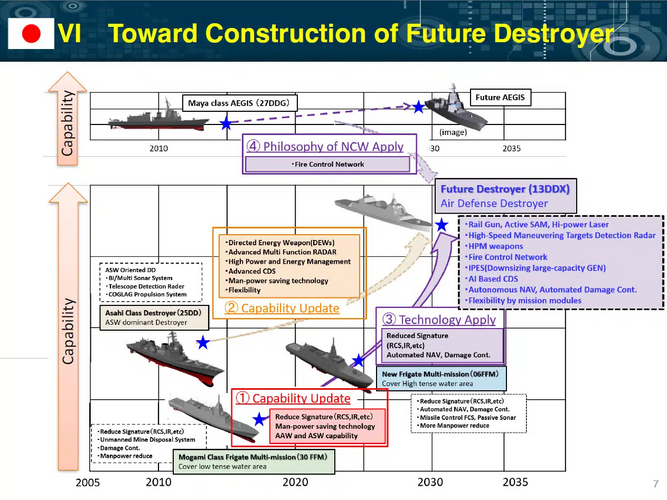
Last edited:
Scott Kenny
ACCESS: USAP
- Joined
- 15 May 2023
- Messages
- 11,599
- Reaction score
- 14,276
If the SPY-7 really is optimized for BMD work versus the SPY-6 optimized for AAW, I suspect that the 11DDGs will get SPY-6.However, it is still unclear what radar will be mounted on the 11DDG.
Personally, I hope they stick with the selection of SPY-7 for continuity.
Remember, the big ASEVs are a replacement for an Aegis Ashore BMD system.
Ares
Man from Far East
- Joined
- 15 October 2018
- Messages
- 102
- Reaction score
- 453
LM claims that the SPY-7 is as versatile as SPY-6. So, if the JMSDF is satisfied with the SPY-7's AAW performance, adding another logistics network won't be necessary.If the SPY-7 really is optimized for BMD work versus the SPY-6 optimized for AAW, I suspect that the 11DDGs will get SPY-6.
Remember, the big ASEVs are a replacement for an Aegis Ashore BMD system.
- Joined
- 3 June 2011
- Messages
- 18,334
- Reaction score
- 12,225
And China and South Korea. . .USN: "It Is VeRy HaRd To CrEaTe A nEw LaRgE wArShIp."
JMSDF: "Hold my sake and watch this."
aonestudio
I really should change my personal text
- Joined
- 11 March 2018
- Messages
- 2,964
- Reaction score
- 7,492
- Joined
- 11 February 2010
- Messages
- 1,650
- Reaction score
- 2,700
The selection between SPY-6 vs SPY-7 for further vessels or other type is probably boils down to how strong the lobbying in the top.
Like afaik SPY-6 sponsors in Japan is Melco while SPY-7 is Fujitsu. Perhaps SPY 6 would end up being upgrade option for earlier Aegis ships like Kongo, Atago and Maya, while SPY-7 is for the further ASEV batch. This way everyone happy.
Like afaik SPY-6 sponsors in Japan is Melco while SPY-7 is Fujitsu. Perhaps SPY 6 would end up being upgrade option for earlier Aegis ships like Kongo, Atago and Maya, while SPY-7 is for the further ASEV batch. This way everyone happy.
Scott Kenny
ACCESS: USAP
- Joined
- 15 May 2023
- Messages
- 11,599
- Reaction score
- 14,276
If that is true, then I would highly encourage Japan to buy SPY7 and stick to a single logistics network.LM claims that the SPY-7 is as versatile as SPY-6. So, if the JMSDF is satisfied with the SPY-7's AAW performance, adding another logistics network won't be necessary.
My objection is based strictly on the assumption that SPY7 was chosen because it was better for BMD and suffered in AAW in exchange.
That might work.The selection between SPY-6 vs SPY-7 for further vessels or other type is probably boils down to how strong the lobbying in the top.
Like afaik SPY-6 sponsors in Japan is Melco while SPY-7 is Fujitsu. Perhaps SPY 6 would end up being upgrade option for earlier Aegis ships like Kongo, Atago and Maya, while SPY-7 is for the further ASEV batch. This way everyone happy.
Though I will note that Japan seems to design their ships for a shorter service life, to keep the shipyards busy designing a new class every decade or so. Which means that it's about time to retire the Kongos, not re-radar them.
Forest Green
ACCESS: Above Top Secret
- Joined
- 11 June 2019
- Messages
- 9,496
- Reaction score
- 17,358

Japan's ASEV Super Destroyer: Fresh Details Unveiled - Naval News
The mock-up of the Japan's future AEGIS System Equipped Vessel (ASEV), a large destroyer was showcased at IDEX 2025.
Scott Kenny
ACCESS: USAP
- Joined
- 15 May 2023
- Messages
- 11,599
- Reaction score
- 14,276
Only 12ktons standard, and maybe 14k full? Smaller ship than I think everyone was expecting. Probably needed to save some money.
Japan's ASEV Super Destroyer: Fresh Details Unveiled - Naval News
The mock-up of the Japan's future AEGIS System Equipped Vessel (ASEV), a large destroyer was showcased at IDEX 2025.www.navalnews.com
- Joined
- 9 October 2009
- Messages
- 21,953
- Reaction score
- 13,594
That could end up backfiring rather badly.Only 12ktons standard, and maybe 14k full? Smaller ship than I think everyone was expecting. Probably needed to save some money.
On another note, from the article:
The Ministry of Defense emphasizes the SPY-7 radar to be installed on two ASEVs has five times the tracking capability of the existing SPY-1 radar and can deal with not only ballistic missiles on lofted trajectories but also multiple ballistic missiles launched simultaneously.
The defense ministry plans to equip the ASEVs with the upgraded Type 12 SSM (ship-launched type), the Tomahawk cruise missile, and high-power laser system, which are scheduled to be installed on the ASEVs after 2032. Not only that, the defense ministry plans to install the Glide Phase Interceptor (GPI), a next-generation missile defense system, specifically designed to shoot down hypersonic missiles on the two ASEVs and the JMSDF’s Aegis destroyers.
I'm dubious of the 14K full displacement figure, as quoted its 190 m length and 26 m beam which the same as Zumwalt whose displacement quoted as 16,000 metric tons and the Japanese claim ASEV its 1.7 times heavier than the US Navy’s newest Arleigh Burke-class Flight III destroyer in terms of displacement, CBO quotes Burke Flt III as 9,714 lt - 9,807 mt and times 1.7 equates to 16,700 mt, not 14,000.Only 12ktons standard, and maybe 14k full? Smaller ship than I think everyone was expecting. Probably needed to save some money.
The standard displacement definition of JMSDF vessel is often quite different from others, which they purposely reported it lower by a certain percentage.
The ASEV, as the flagship for ABM mission, will of course have flag space, just like the other JMSDF Aegis vessels.
One thing JMSDF quite different from USN is that they rarely perform MLU to their vessels. Probably that's one of the motivation for JMSDF to build new vessels.
The ASEV, as the flagship for ABM mission, will of course have flag space, just like the other JMSDF Aegis vessels.
One thing JMSDF quite different from USN is that they rarely perform MLU to their vessels. Probably that's one of the motivation for JMSDF to build new vessels.
Scott Kenny
ACCESS: USAP
- Joined
- 15 May 2023
- Messages
- 11,599
- Reaction score
- 14,276
I think it's the other way around. Because Japan recognizes the need to keep their shipyards busy, they don't do MLUs and instead buy new every 12 years or so.One thing JMSDF quite different from USN is that they rarely perform MLU to their vessels. Probably that's one of the motivation for JMSDF to build new vessels.
Standard displacement tonnage is without fuel, but as don't think ASEV will have such a large capacity of 4,700 mt of fuel and so think the same as you the Japanese Navy definition of Standard Displcement is different, a lower, figure, always wondered if it originated as a way Japan could cheat and have a larger fleet than that prescribed tonnage under the 1922 Washington Treaty which was mutually agreed to limit the size of the Navies, US, Britain, France, Italy and Japan.The standard displacement definition of JMSDF vessel is often quite different from others, which they purposely reported it lower by a certain percentage.
Scott Kenny
ACCESS: USAP
- Joined
- 15 May 2023
- Messages
- 11,599
- Reaction score
- 14,276
That's certainly what popped into my mind, but I highly doubt that they're still using the Imperial definition.Standard displacement tonnage is without fuel, but as don't think ASEV will have such a large capacity of 4,700 mt of fuel and so think the same as you the Japanese Navy definition of Standard Displcement is different, a lower, figure, always wondered if it originated as a way Japan could cheat and have a larger fleet than that prescribed tonnage under the 1922 Washington Treaty which was mutually agreed to limit the size of the Navies, US, Britain, France, Italy and Japan.
Are they maybe using "no fuel, ammunition, or supplies onboard"?
Of course, it is unclear whether this is true or not, but the Japanese wikipedia entry on the amount of water discharged is as follows

 ja.wikipedia.org
ja.wikipedia.org
Standard Discharge Capacity in the Maritime Self-Defense Force
The Maritime Self-Defense Force (MSDF) also publishes the “standard displacement” as an official specification for naval vessels, but its definition is,
The definition is “the amount of water discharged when the ship is fully loaded, excluding fuel, fresh water, consumable supplies (rations, ammunition, etc.), ballast, etc.”[7].
*Rationale: Detailed Rules for Ship Design Standards (enacted in 1978)[6].
It is equal to the construction discharge (the weight of a pure ship)[8].

排水量 - Wikipedia
Standard Discharge Capacity in the Maritime Self-Defense Force
The Maritime Self-Defense Force (MSDF) also publishes the “standard displacement” as an official specification for naval vessels, but its definition is,
The definition is “the amount of water discharged when the ship is fully loaded, excluding fuel, fresh water, consumable supplies (rations, ammunition, etc.), ballast, etc.”[7].
*Rationale: Detailed Rules for Ship Design Standards (enacted in 1978)[6].
It is equal to the construction discharge (the weight of a pure ship)[8].
Similar threads
-
-
-
-
-
JMSDF - CVH Next (Izumo Class Follow-on)
- Started by Ironmiked
- Replies: 2

